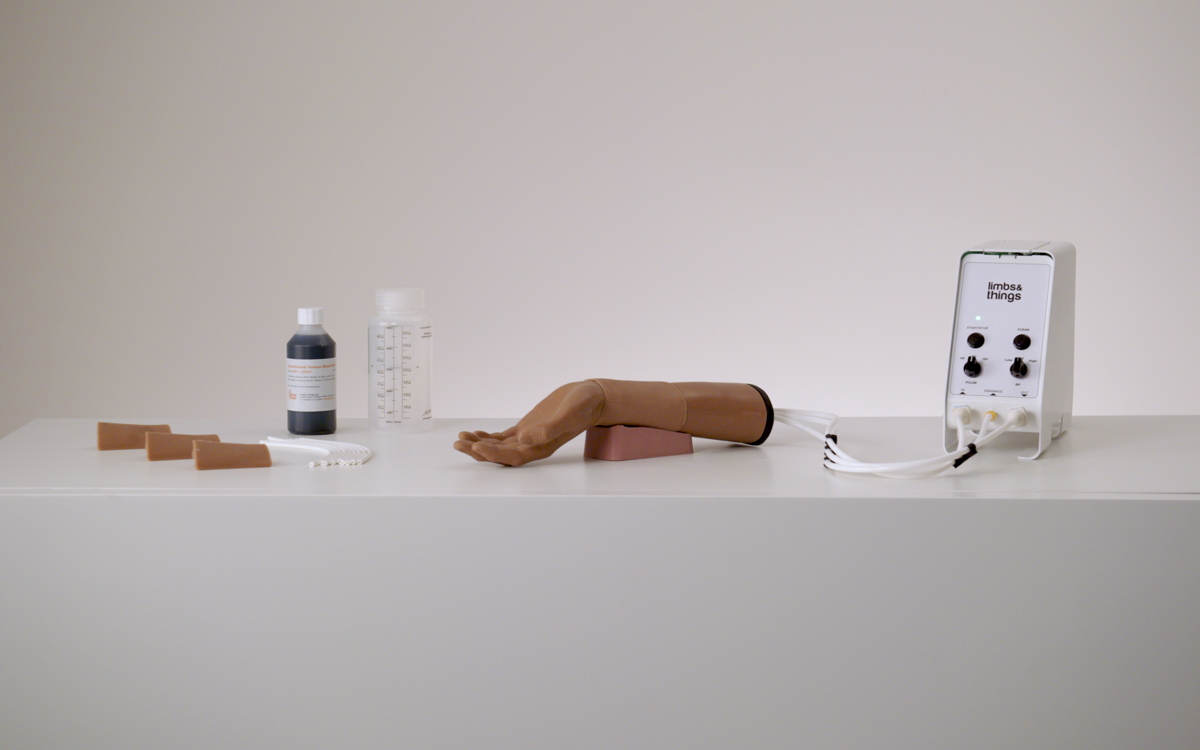



This soft tissue strap-on pad can be used to train in venipuncture and represents the antecubital fossa of the right arm.
Overview
- Ideal for professional-to-patient communication and scenario based training using Simulated Patient
- Tough backing plate to prevent needlestick injuries
- Strap onto the antecubital fossa of the arm
- Veins are: self-sealing for repeated use, re-chargeable via a one-way valve, supplied with mock blood under pressure, and replaceable.
Versatility
- The pad can be connected to the Mock Blood Giving Set
Cleaning
- Replaceable epidermis is washable using soap and water when Limbs & Things mock blood is used
Safety
- These veins contain latex
- Only use Mock Blood
Skills Gained
- Professional-to-patient communication
- Recognition of the vein pattern through palpation
- Insertion of a needle
- Insertion of cannula
- Management of blood flow
Works with the following products:
References
AAMC, Recommendations For Clinical Skills Curricula For Undergraduate Medical Education (2005), p.28 Appendix 7: Clinical Procedures....Correctly perform a Venipuncture • Insert needle at proper angle • Withdraw appropriate amount of blood • Withdraw needle and checks for bleeding • Dress area appropriately • Dispose of needle appropriately
AAFP Residency Guidelines, Care of the Critically Ill Adult (p. 9): Diagnostic and therapeutic procedures ... f. Catheter placement (peripheral IV, arterial line, central venous access)
ACGME General Surgery Milestones (p.8): This resident ... is able to reliably perform basic procedures, including venipuncture..
National Association of State EMS Officials: National Model EMS Clinical Guidelines (2016): Establish Vascular Access if indicated or in patients who are at risk for clinical deterioration; Cardiovascular: Establish IV Access Shock: Establish IV / IO Access Resuscitation: Establish IV without interrupting chest compressions Trauma / Blast Injuries: Establish IV Access with 2 large bore IVs or IOs
Health Workforce Australia, Medical Graduate Competency Framework Stage 2 Final Report, 2012 General Procedural: IV cannulation ( including set up and IV fluid administration), Venepuncture for venous blood sample - performed routinely in the clincal environment under minimal supervision
CPMEC Australian Curriculum Framework for Junior Doctors version 3.1, 2012, p.31 ...provide safe treatment to patients through competently performing certain procedures... Venepuncture IV cannulation Administration of IV medications... and fluids
Practical Skills and Procedures, General Medical Council, April 2019, p.4 & 5 Diagnostic Procedures 5. Take blood cultures: take samples of venous blood to test for the growth of infectious organisms 7. Carry out venepuncture: insert a needle into a patient's vein to take a sample of blood for testing.
NMC Future nurse: Standards of proficiency for registered nurses, 17 May 2018, p.32 2.2 undertake venepuncture and cannulation and blood sampling, interpreting normal and common abnormal blood profiles and venous blood gases
Royal Marsden Manual 9th Ed (2015). Procedure guideline 10.1 Venepuncture. Select the vein by careful palpation; use 23-gauge winged infusion device for small veins; Anchor the vein by applying manual traction on the skin; Insert the needle smoothly at an angle of approx. 30 degrees; reduce the angle once flashback of blood is seen; withdraw blood; remove needle; inspect puncture point before applying a dressing. Procedure guideline 14.4: Peripheral Cannula insertion: Assess and select vein; Anchor the vein; hold the cannula in the dominant hand, ensure it is in the bevel up position; insert the cannula through the skin; wait for first flashback of blood and then withdraw the stylet slightly; advance the cannula; attach a primed extension set, needless injection cap or administration set.
NHS National Practitioner Program: Matrix Specification for the Physician Associate (2016). p.127: Core Procedural Skills: Venepuncture; IV cannulation
Specialty Training Curriculum For Core Medical Training, 20013 (p.165): The CMT StR is expected to be competent, and maintain competency, in the following practical procedures in the Foundation curriculum during Core Medical Training: ...Venepuncture
GMC Outcomes for provisionally registered doctors with a licence to practise (The Trainee Doctor), 2015 p. 8: Core clinical and procedural skills ...: Venepuncture, IV cannulation













